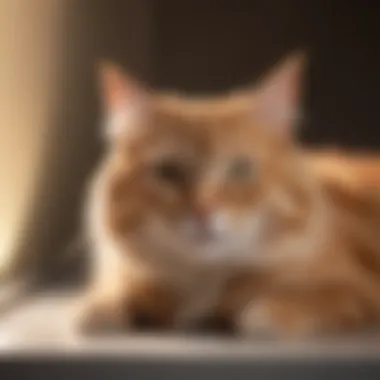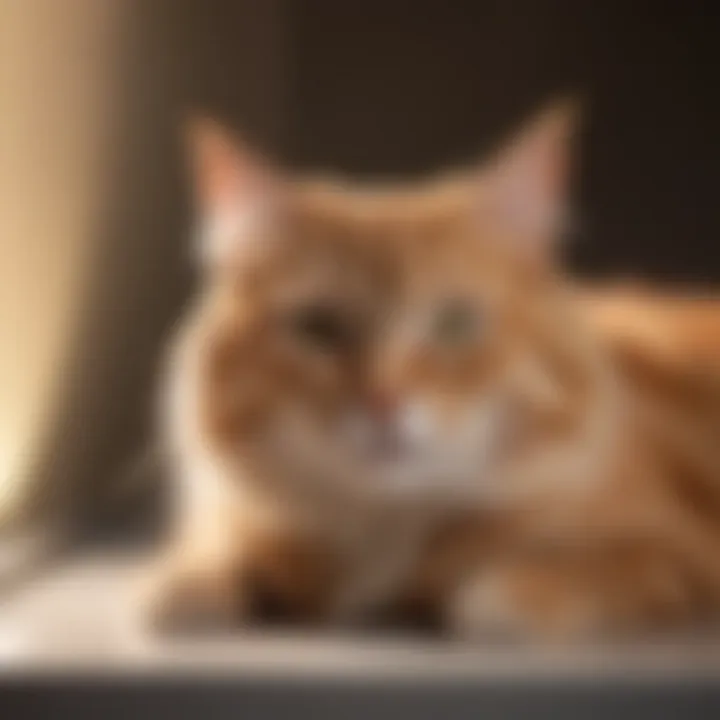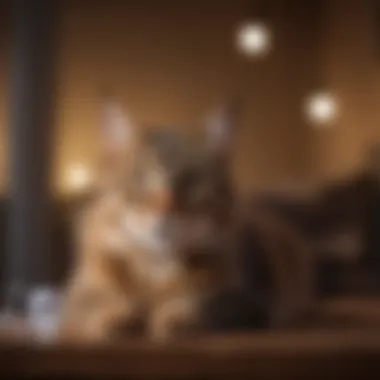Exploring Light Therapy for Cats: A Comprehensive Guide


Intro
Light therapy for cats is an innovative concept that is gaining traction among pet owners. It uses specific wavelengths of light to aid in healing and calming cats, addressing various physical and emotional needs. This guide aims to shed light on the different aspects of this therapy, allowing cat owners to understand its potential benefits and applications.
Understanding Your Pet
Understanding the specific needs of your cat is crucial. Different breeds of cats come with their own sets of traits and temperaments, which can affect how they respond to light therapy.
Breed Traits
Distinct breeds, such as Siamese or Maine Coons, may exhibit unique sensitivities and health profiles. Siamese, for example, are known for their vocal nature and companionship needs. In contrast, Maine Coons tend to be hardy and sociable but require special attention to potential genetic health issues. Recognizing these traits helps in tailoring light therapy to maximize its efficacy.
Common Temperaments
Cats' temperaments are diverse, influenced not only by breed but also by individual experiences. Some cats may be naturally anxious, while others are more relaxed. Light therapy can play a role in helping to soothe anxious pets, particularly when introduced in a comfortable environment. Understanding these nuances allows owners to create a safe and welcoming ambiance for therapy.
Special Needs
Cats with specific health issues such as arthritis or skin conditions can benefit significantly from light therapy. It provides an alternative or complementary option to traditional treatments. Pet owners must remain vigilant about their furry friends' special needs and consult with veterinarians before implementing any new therapies.
Pet Care Essentials
A solid foundation of pet care is essential before incorporating light therapy. This section focuses on nutrition, grooming, and overall health, which sets the stage for effective treatment.
Nutrition and Feeding Guidelines
Proper nutrition enhances overall health and vitality. Ensuring a balanced diet that meets the cat's specific needs is vital. Consult with a veterinary nutritionist to discern the best food choices, focusing on quality ingredients suitable to the cat's age and health status.
Grooming Tips and Techniques
Regular grooming affects both physical appearance and emotional well-being. Establish a routine that includes brushing, nail trimming, and ear cleaning. This not only fosters bonding but also helps to detect any skin issues that light therapy could remedy.
Health and Wellness
Routine veterinary check-ups are necessary. Keeping up with vaccinations, dental care, and preventive treatments will help in maintaining a healthy pet. Cats with underlying health issues may require more frequent assessments, ensuring they are good candidates for light therapy.
Synthesizing Information
In summary, a comprehensive understanding of one's pet is essential for effective use of light therapy. By being attuned to breed traits, common temperaments, and special needs, pet owners can enhance their cats' health and well-being through targeted approaches. This process involves a holistic view of pet care essentials, preparing the pathway for interventions like light therapy to deliver their maximum potential benefit.
Prolusion to Light Therapy for Cats
Light therapy is becoming increasingly important in the field of veterinary medicine, particularly for felines. As pet owners seek alternative treatments that enhance the well-being of their cats, understanding light therapy plays a critical role. This method involves using specific wavelengths of light to promote healing and alleviate various medical conditions. The advantages of light therapy can significantly improve a cat'squality of life, making it a topic well worth exploring.
Defining Light Therapy
Light therapy, often referred to as phototherapy, is a non-invasive treatment that uses light to enhance biological processes. It involves the application of lasers or LEDs at specific wavelengths to achieve therapeutic effects. In the context of feline health, light therapy can target tissue repair, pain reduction, and several other beneficial outcomes. Owners may find the prospect of using light therapy appealing due to its painless nature and the low frequency of side effects compared to more traditional medical interventions. Its applications can be diverse, which adds to its usefulness as an adjunct therapy or even a standalone treatment in some scenarios.
Historical Context of Light Therapy
The concept of using light for healing can be traced back to ancient civilizations. The Egyptians and Greeks utilized sunlight for its therapeutic benefits. However, the modern understanding of light therapy began to take shape in the early 20th century, thanks to advancements in medical research. As scientists explored the effects of light on human health, similar studies began to emerge for animals, including cats. With growing evidence supporting its effectiveness, light therapy has gained acceptance in veterinary practices around the world. This historical backdrop not only highlights its significance in animal care but also emphasizes the need for pet owners to stay informed about such innovative treatments.
Understanding the Mechanisms of Action
A thorough examination of the mechanisms of action behind light therapy is crucial for understanding its benefits. This section will focus on how light interacts with biological tissues and influences cell behavior. Understanding these mechanisms helps cat owners appreciate the science that underlies this treatment method. It also facilitates informed discussions with veterinarians and aids in assessing whether light therapy is suitable for their feline companions.
Photobiomodulation Explained
Photobiomodulation (PBM) is the foundation of how light therapy exerts its clinical effects. Through the use of specific wavelengths of light, PBM stimulates cellular processes by promoting adenosine triphosphate (ATP) production. ATP is the energy currency of cells, essential for maintaining cellular function and promoting healing.
When light penetrates the skin, it is absorbed by cellular photoreceptors, most notably cytochrome c oxidase, which is located in the mitochondria. The absorption of light energy leads to a boosted electron transfer through the respiratory chain, resulting in increased ATP synthesis.
Here are key features of photobiomodulation:


- Wavelength Specificity: The effectiveness of PBM is influenced by the wavelength of light used. Commonly, red and near-infrared wavelengths are utilized, as they penetrate tissues more effectively.
- Dose-Dependence: The therapeutic effects of PBM are dose-dependent, meaning the intensity and duration of light exposure can impact the degree of cellular response.
- Non-Thermal Effects: Unlike more traditional laser therapies, PBM does not cause thermal damage which is why it is considered a non-invasive approach.
Understanding PBM is vital for pet owners who seek to utilize light therapy for their cats. It provides a basis for explaining how light can promote healing, encourage cell repair, and reduce inflammation.
Effects on Cellular Function
The effects of light therapy on cellular function are numerous and significant. Once light is absorbed by the cells, several biochemical reactions are initiated. These reactions enhance various cellular processes that contribute to overall health and recovery.
Here are some notable effects of light therapy on cellular function:
- Enhanced Healing: Light exposure accelerates wound healing and tissue repair by promoting fibroblast proliferation and collagen synthesis. This is particularly beneficial for cats recovering from surgical procedures or injuries.
- Anti-Inflammatory Response: Light therapy can modulate the inflammatory response, reducing swelling and pain. This is especially important in conditions such as arthritis or other musculoskeletal disorders.
- Improved Circulation: Light stimulates the formation of new capillaries in tissues, enhancing blood flow, which is crucial for delivering oxygen and nutrients to cells.
- Pain Relief: By modulating pain signals in the nervous system, light therapy may provide an analgesic effect. This can lead to a reduction in the reliance on medications for managing pain in cats.
In summary, the mechanisms of action behind light therapy, particularly photobiomodulation, reveal its potential to influence cellular function positively. This understanding helps cat owners and caregivers evaluate the role of light therapy in managing various health issues in their pets.
Types of Light Therapy Technologies
Understanding the various types of light therapy technologies is essential for pet owners considering this treatment for their cats. Each technology has specific applications, benefits, and operational methods that can influence the effectiveness of the therapy. By recognizing the nuances between these two primary forms, cat owners can make informed decisions that best suit their pets' conditions and needs.
Laser Light Therapy
Laser light therapy utilizes concentrated beams of light to penetrate deeper layers of tissue. This approach allows for targeted treatment of specific areas, making it beneficial for conditions requiring precision.
Laser therapy operates primarily on the principle of photobiomodulation, where the energy from laser light stimulates cellular activities. The heat generated by the laser is typically mild, promoting healing without causing discomfort to the cat.
Benefits of Laser Therapy
- Precision Treatment: Allows for targeting specific tissues or injury sites.
- Quick and Effective: Sessions are usually brief, generally lasting between 5 to 15 minutes.
- Pain Relief: Many owners report an immediate reduction in their pet's discomfort after treatment.
Considerations
While laser therapy can be very effective, it is essential to ensure that the administering veterinarian is experienced with this specific technology. The quality of the laser device also matters, as different lasers produce varying wavelengths and intensities, which can affect outcomes.
LED Light Therapy
LED light therapy is another effective light treatment modality. This technology employs light-emitting diodes to deliver treatment through broader light waves. As a result, it often covers larger areas of skin and tissue at once.
LED therapy functions using specific wavelengths of light that can trigger biological processes such as inflammation reduction and increased blood circulation. Unlike laser therapy, LED light is generally less intense but can still provide substantial benefits over time.
Benefits of LED Therapy
- Ease of Use: Devices are often more user-friendly for home applications.
- Safety: Lower risk of injury compared to stronger laser beams.
- Versatile Applications: Useful for a range of conditions, including skin disorders and general wellness.
Considerations
Cat owners should keep in mind that LED therapy may require more frequent sessions to achieve desired results compared to laser therapy. Consultation with a veterinary professional can help determine the best approach based on the specific health needs of the cat.
Applications of Light Therapy in Feline Health
Light therapy, while still emerging, shows a lot of promise in improving the health of cats. This section summarizes how it may benefit our feline companions, covering pain management, wound healing, and skin conditions. Understanding these applications is vital for pet owners considering this innovative treatment option.
Pain Management
Pain is a common issue for many cats, often caused by aging, injury, or various health conditions. Light therapy can play an important role in alleviating this discomfort. It promotes healing by improving blood circulation and reducing inflammation, allowing for faster recovery from injuries. The use of light can stimulate the body's natural healing processes, making it a non-invasive option for pain relief.
Research has also shown that light therapy can help manage chronic pain conditions like arthritis in cats. Regular sessions can help reduce pain sensitivity and improve mobility, enhancing overall quality of life. This aspect of light therapy makes it essential for pet owners to consider, especially those with senior cats or those recovering from surgery.
Wound Healing
Wound healing in cats can be a lengthy process, and complications can arise. Light therapy aids in this process by accelerating cellular regeneration and reducing healing time. The light energy penetrates the skin to reach deeper tissues, promoting faster collagen formation. This leads to improved skin repair, which is crucial for managing various types of wounds, including surgical incisions and traumatic injuries.
Furthermore, the anti-inflammatory effects of light therapy can prevent the body from overreacting to injuries, thus minimizing swelling. Many veterinary professionals advocate for its use in post-operative care, ensuring better outcomes for cats undergoing surgical procedures. Considering this, light therapy offers a valuable tool for enhancing the healing process.
Skin Conditions
Feline skin conditions, such as allergies, infections, or dermatitis, often require careful management. Light therapy can assist in relieving symptoms associated with these conditions. By using specific wavelengths of light, it can target the inflammation and promote healing of the skin.


In addition, light therapy has been found effective in treating fungal and bacterial infections, reducing the need for harsh medications. It creates a more comfortable experience for the cat, as the treatment is non-invasive and generally well-tolerated. Addressing skin issues promptly is critical, and incorporating light therapy into the treatment plan can provide significant benefits.
Light therapy can offer a comprehensive approach to managing various health issues in cats, allowing for improved recovery and enhanced well-being.
In summary, the applications of light therapy in feline health are diverse and impactful. As pet owners explore innovative solutions for their cats, understanding these applications helps in making informed decisions tailored to their pet's needs.
Discussing the Benefits of Light Therapy
Light therapy is increasingly recognized for its potential to improve the health of cats. As awareness grows, it's clear that this treatment method offers multiple benefits for both feline patients and their owners. Understanding these advantages is crucial in evaluating whether light therapy is a suitable option for your cat. Here we discuss the benefits in detail, focusing on its non-invasive nature, reduced reliance on pharmaceuticals, and overall improvements to the quality of life for cats.
Non-Invasive Nature
One of the primary benefits of light therapy is that it is non-invasive. This means that it does not require surgical procedures or injections, which can cause stress and discomfort for cats. Instead, light therapy involves the application of low-level laser or LED light on the affected areas of the cat’s body.
This method promotes healing without the discomfort associated with more invasive treatments. Cats typically tolerate these sessions well, making it easier for pet owners to administer the therapy at home if recommended by their veterinary professional. Additionally, because light therapy is painless, it reduces the anxiety that may arise from veterinary visits. Overall, its non-invasive nature makes it an appealing option for many pet owners looking for alternatives to traditional treatments.
Reduced Need for Pharmaceuticals
Another significant advantage of light therapy is its potential to reduce the need for pharmaceuticals. Pain management in cats often involves prescription medications, which can have side effects and may not always be effective. Light therapy works at a cellular level, helping to alleviate pain and inflammation naturally.
Using light therapy may lead to a decrease in the dosage or frequency of medications required. This not only helps maintain better health through natural means but also can improve the overall well-being of the cat. As a pet owner, this is a compelling reason to consider light therapy, as it provides a more holistic approach to managing health issues in felines without relying solely on medication.
Improved Quality of Life
The culmination of these benefits is a significant improvement in the quality of life for cats undergoing light therapy. The reduction in pain and accelerated healing can have profound effects on a cat's daily activities. Healthier cats can return to their playful behavior, enjoy interacting with their human companions, and engage in activities they love.
Moreover, light therapy can contribute to faster recovery from injuries or surgical procedures. Ensuring your pet has the opportunity to live a fulfilling life is an important goal for any cat owner. Light therapy addresses that need directly by providing an effective, compassionate approach to feline health.
The increasing recognition of light therapy in cat treatment highlights a shift towards more innovative and holistic methods in veterinary care.
In summary, discussing the benefits of light therapy involves understanding its non-invasive nature, reduced reliance on pharmaceuticals, and the overall enhancement of a cat's quality of life. These factors not only reinforce the efficacy of light therapy but also align with the desires of pet owners seeking the best care for their beloved companions.
Considerations for Cat Owners
When exploring light therapy for cats, it is critical for pet owners to consider several factors. These considerations can influence the overall effectiveness of the treatment and the well-being of the feline. Understanding available options, potential risks, and individual cat needs should guide any decisions about implementing light therapy.
Consulting with Veterinarians
Before starting any treatment, consulting with a veterinarian is essential. A veterinarian offers professional insights based on a cat's unique health profile. They can help determine if light therapy is suitable for a particular condition. Additionally, they might suggest specific equipment or products, like those from companies such as Lumenis or VetLaser Systems. Ensure that your veterinarian is knowledgeable about light therapy's benefits and limitations.
It is also important to ask about the pet's current health status, previous treatments, and any contraindications related to the cat's medical history. For example:
- Age of the cat
- Any prior adverse reactions to therapies
- Concurrent conditions that could affect treatment
These factors are crucial in creating a tailored approach to your cat's health care.
Assessing Suitability for Your Cat
Every cat is different. Assessing the suitability of light therapy for your pet requires understanding both the treatment and your cat's specific needs. Factors like age, temperament, and existing health conditions should be considered. For instance, older cats with chronic pain might benefit more from light therapy than younger, healthy cats. Moreover, different types of light therapy—such as LED or laser—may be more appropriate depending on the condition being treated.
Observe how your cat reacts to environmental changes. Some cats may be agitated by new equipment or processes. A gradual introduction to light therapy can be helpful, allowing your cat to become familiar with the therapy’s methods. Always prioritize the comfort of your cat during any therapy.
In summary, light therapy presents a promise for improving feline health. Yet, proper considerations must be in place. Collaborating with a veterinary professional and assessing your cat's unique situation will provide guidance in this therapeutic journey.
Important Qualifying Statement: Every cat is unique. Individual assessments are crucial to the successful application of light therapy.
Risks and Limitations of Light Therapy
Light therapy is a growing field in feline health, but like any treatment, it comes with its own set of risks and limitations. Understanding these aspects is essential for cat owners who wish to make informed choices about their pets' health. This section outlines potential side effects and the specific situations where light therapy may not yield the desired outcomes.
Potential Side Effects
While light therapy is generally considered safe for cats, some pets may experience side effects. It's essential to monitor the animal during and after treatment sessions. Common potential side effects include:


- Skin Irritation: Some cats may have sensitive skin which could react to the light or the heat produced by the device. Owners should watch for any signs of redness or discomfort on their cat's skin.
- Discomfort During Sessions: A few cats might feel uneasy due to the unfamiliar nature of the therapy. This discomfort can manifest as restlessness or signs of anxiety.
- Temporary Fatigue: Light therapy can spur cellular regeneration and healing. This process may cause temporary tiredness in some cats as their bodies adapt and recover.
It is crucial for owners to consult with a veterinarian to weigh these potential side effects against the benefits. Regular communication with a vet can help determine if the light therapy is appropriate and beneficial for the individual cat's health status.
Situations Where Light Therapy May Not Be Effective
There are certain conditions and scenarios where light therapy might not be the best course of action. Not all health issues respond to light therapy, and it is vital for pet owners to understand its limitations. Here are several examples:
- Severe or Acute Injuries: In cases of severe trauma or critical injuries, light therapy may not provide immediate relief or adequate healing support. Traditional veterinary treatment may be necessary.
- Underlying Health Conditions: If a cat suffers from specific underlying health conditions, such as certain types of cancers or systemic diseases, light therapy might not be effective. It is important to consult with a vet who can provide insights into tailored treatment options.
- Incompatibility with Other Treatments: Light therapy could interfere with certain medications or other therapeutic approaches. Therefore, openness with a veterinarian about all the treatments an animal is undergoing is essential to avoid complications.
Always prioritize a cat's overall health and well-being. Discuss all potential therapies with a veterinarian before making treatment decisions.
In summary, while light therapy offers beneficial aspects for many cats, it is crucial for pet owners to be aware of the risks and limitations associated with its use. Awareness allows for balanced decision-making, ensuring the approach taken is in the best interest of their feline companions.
How to Administer Light Therapy at Home
Administering light therapy at home represents an important step for cat owners interested in enhancing the health and well-being of their pets through non-invasive means. The home environment can be very beneficial for the application of light therapy, as it allows for personalized treatment schedules and comforts familiar to the cat. However, with this capability comes a responsibility to ensure proper use, safety, and effectiveness.
Devices Available for At-Home Use
Several devices designed for home use make light therapy accessible to cat owners. These range in technology and application methods, catering to different needs and preferences.
- Laser Pointers: Often used for targeted treatment in specific areas, they deliver concentrated light to alleviate pain.
- LED Light Panels: These panels can cover larger areas and are suitable for treating multiple conditions simultaneously.
- Handheld Units: Portable and versatile, handheld units allow more control over light application.
- Light Therapy Mats: Designed for cats to lie on, these mats provide a gentle light exposure over larger body areas, ideal for general wellness.
Each device has its unique specifications and benefits. Selection should depend on the specific needs of your cat and your own comfort level with the device. It is crucial to research suitable options and, if possible, seek recommendations from your veterinarian.
Safety Guidelines for Home Application
Although light therapy is generally considered safe, certain guidelines must be followed to avoid potential mishaps.
- Consult with a Veterinarian: Before initiating therapy, consult your vet to confirm it is suitable for your cat's condition.
- Follow Instructions Carefully: Each device will come with user instructions. Adhere to them closely for effectiveness and safety.
- Limit Exposure Times: Avoid prolonged exposure. Start with shorter sessions to gauge how your cat reacts to the therapy.
- Monitor Your Cat: Always supervise your pet during light therapy. Look for signs of discomfort or unusual reactions.
- Keep Devices Clean: Hygiene is crucial. Ensure that the devices you use are properly maintained and sterilized, as this helps to prevent any potential infections or irritations.
"Light therapy can be a fine addition to a cat’s wellness plan, but it must be applied thoughtfully to be effective and safe."
The home setting can be an effective environment for applying light therapy. Ensuring appropriate devices and safety measures are in place will maximize the benefits while minimizing risks. This careful approach promotes a positive experience for both cats and their owners.
Expert Recommendations on Light Therapy
Veterinary professionals and animal physiotherapists play an essential role in guiding pet owners regarding the application of light therapy for cats. Their insights are crucial in understanding the specific needs of each feline patient and in optimizing treatment outcomes. This section addresses the expert recommendations related to light therapy, emphasizing the importance of professional advice in the therapeutic decision-making process.
Veterinary Insights
Veterinarians offer a solid foundation for understanding the health and well-being of cats. Their experience allows them to recognize when light therapy could be beneficial. For example, veterinarians evaluate individual health conditions before suggesting light therapy. They consider factors like the cat's age, underlying health issues, and overall behavior. This initial assessment is vital because it ensures that light therapy is appropriate for a specific situation.
Moreover, veterinarians often determine the appropriate type of light therapy suitable for the cat. They can recommend specific devices based on the needs of the pet, such as laser light therapy or LED options. If a particular light therapy is indicated, veterinarians will guide the owner on frequency and duration of use, ensuring that it aligns with the feline's health requirements. Their ongoing monitoring is also important, as they can adjust the treatment plan based on the cat's response to therapy.
Veterinary guidance helps minimize risks associated with untreated conditions or incorrect therapy applications. It promotes a holistic approach to the feline's care, combining light therapy with other necessary interventions.
Expert Opinions from Animal Physiotherapists
Animal physiotherapists bring unique perspectives to the benefits of light therapy for cats. They emphasize not only recovery from injury but also maintaining optimal mobility and function. Physiotherapists educated in light therapy explain how it can facilitate tissue repair and reduce inflammation. They often advocate for a combination of therapeutic approaches, indicating that light therapy can be more effective when used alongside physical rehabilitation techniques.
Physiotherapists encourage tailored rehabilitation plans that include light therapy based on the cat's specific ailments. For instance, for a cat recovering from surgery, they might advise the incorporation of light therapy into a broader rehab schedule.
Furthermore, physiotherapists can provide practical tips on how to effectively use the therapy at home, ensuring safety and efficacy. They may assist in training pet owners on specific techniques or routines that enhance treatment outcomes.
"Professional oversight is vital for implementing light therapy safely and effectively for cats. Misapplication can lead to undesirable effects or incomplete healing."
In summary, the recommendations from veterinarians and animal physiotherapists signify the importance of professional insight in the use of light therapy. Their expert knowledge aids pet owners in navigating the therapeutic landscape, promoting better health outcomes for their feline companions.
Epilogue: The Future of Light Therapy for Cats
Light therapy for cats signifies a progressive approach to enhancing animal health. This treatment merges technology with veterinary science, potentially transforming how various conditions are treated in felines. The current landscape shows significant promise for further development in this field.
Emerging Research and Trends
Recent studies indicate a growing body of evidence supporting light therapy's effectiveness. Research is expanding into various applications, such as its use for post-surgical healing and managing chronic pain. A multitude of new devices, including portable LED units, have been created to cater to pet owners. These innovations enhance accessibility, allowing for widespread use in home care.
At the same time, there are ongoing clinical trials that aim to evaluate light therapy's efficacy on specific ailments like arthritis or dermatological conditions in cats. The aim of these studies is to provide more conclusive data about treatment duration, light intensity, and frequency, which may lead to refined protocols for use in home setups.
*“The evolution of light therapy is continuously redefining how we perceive traditional veterinary treatments.



